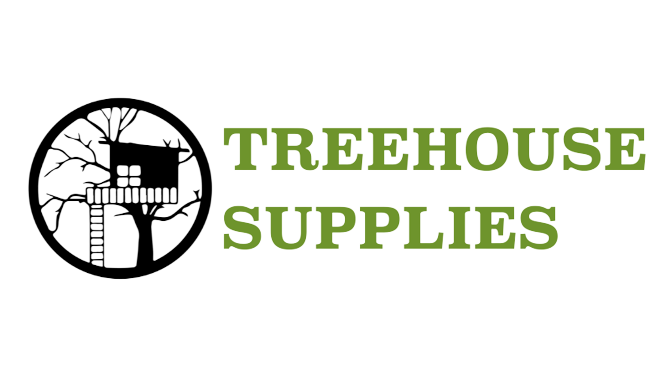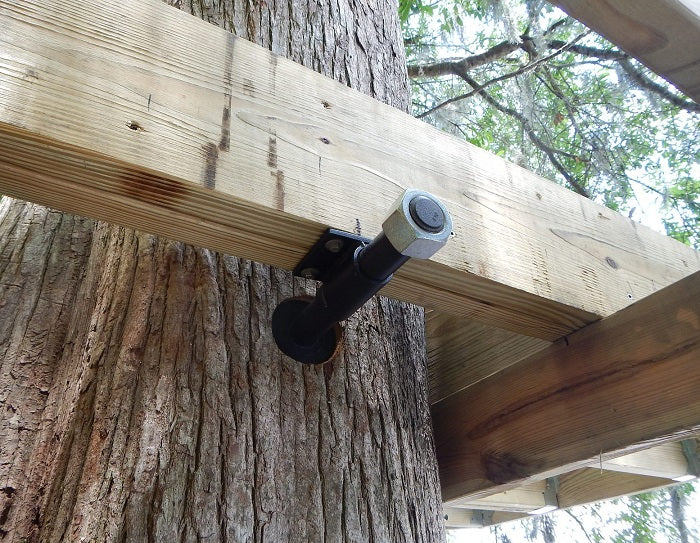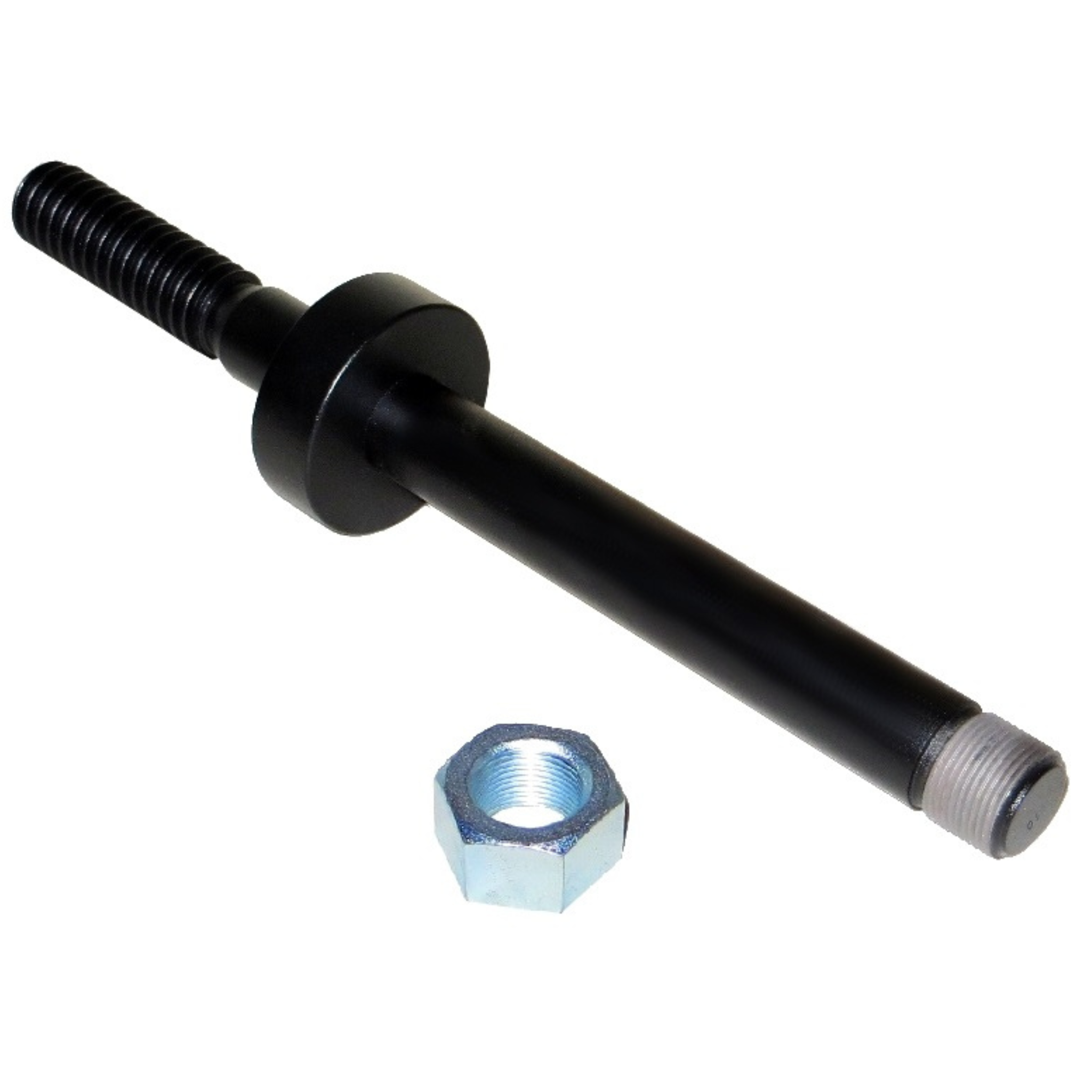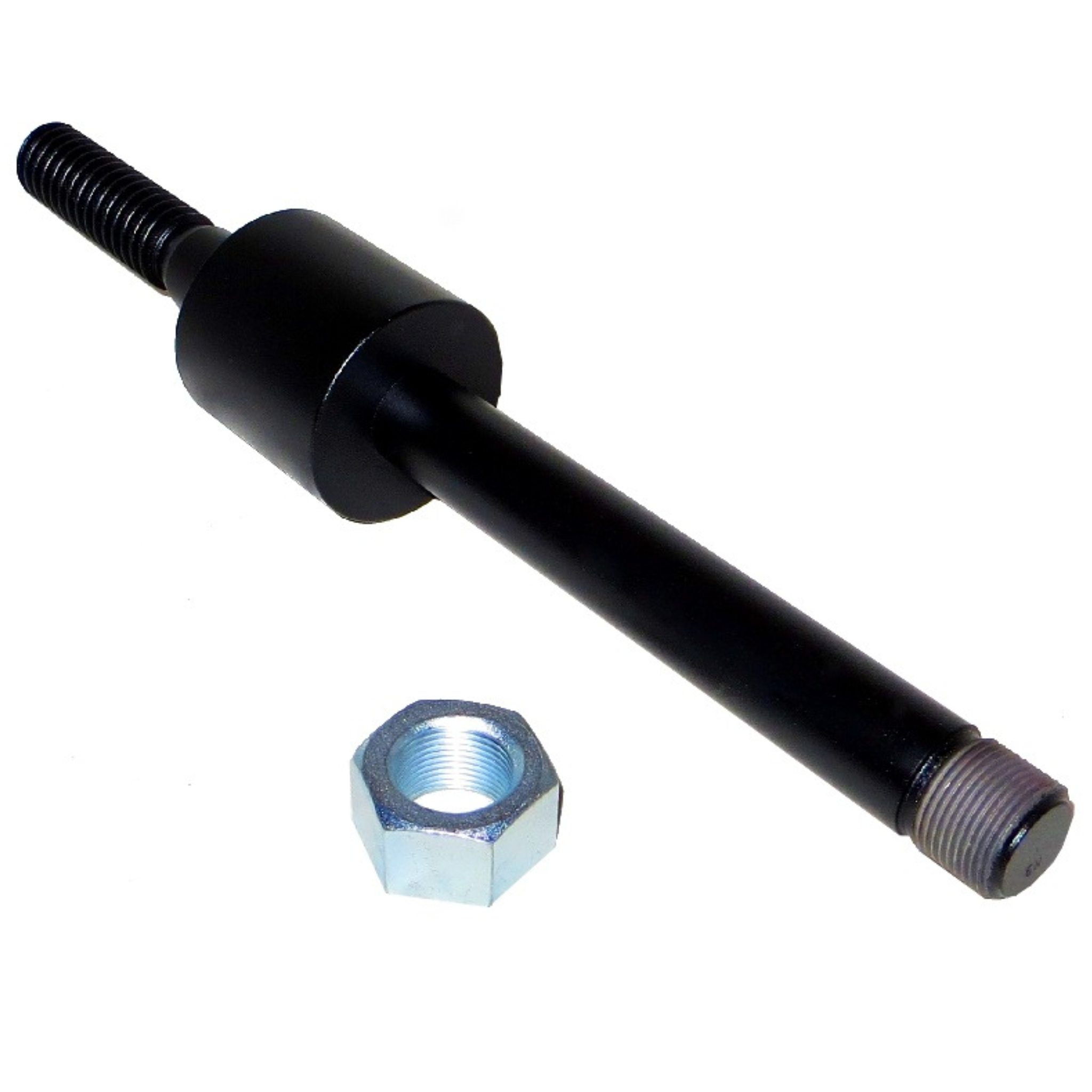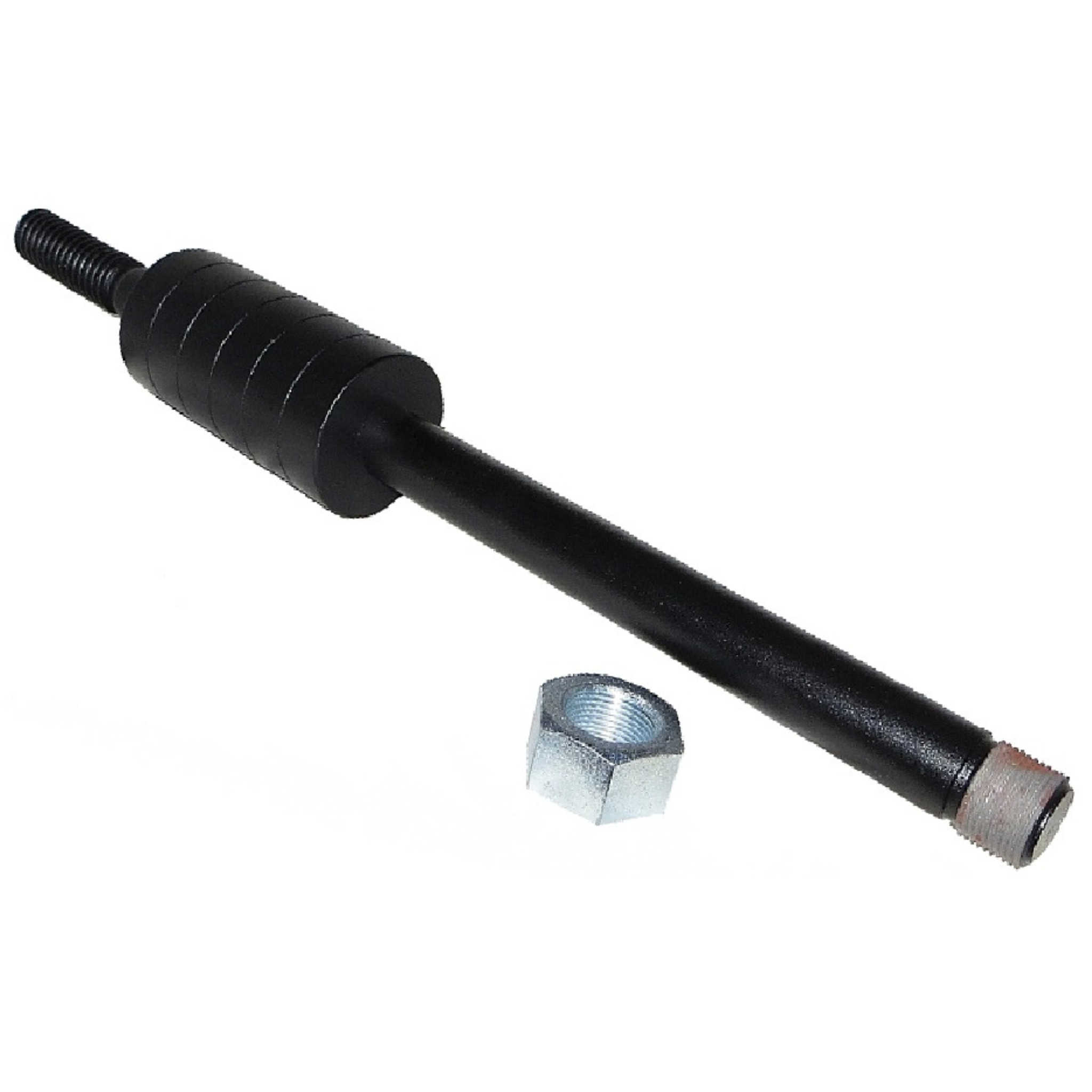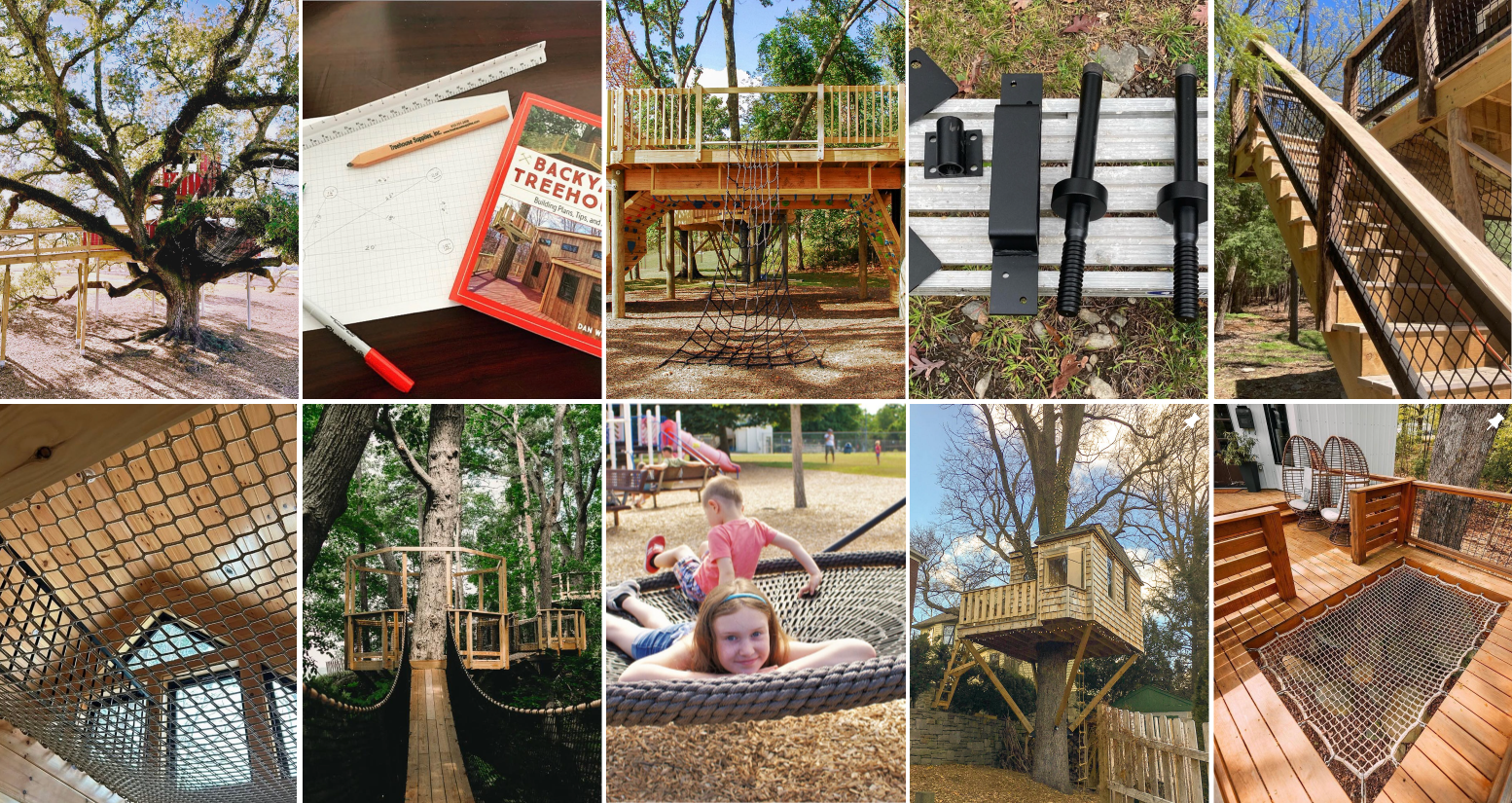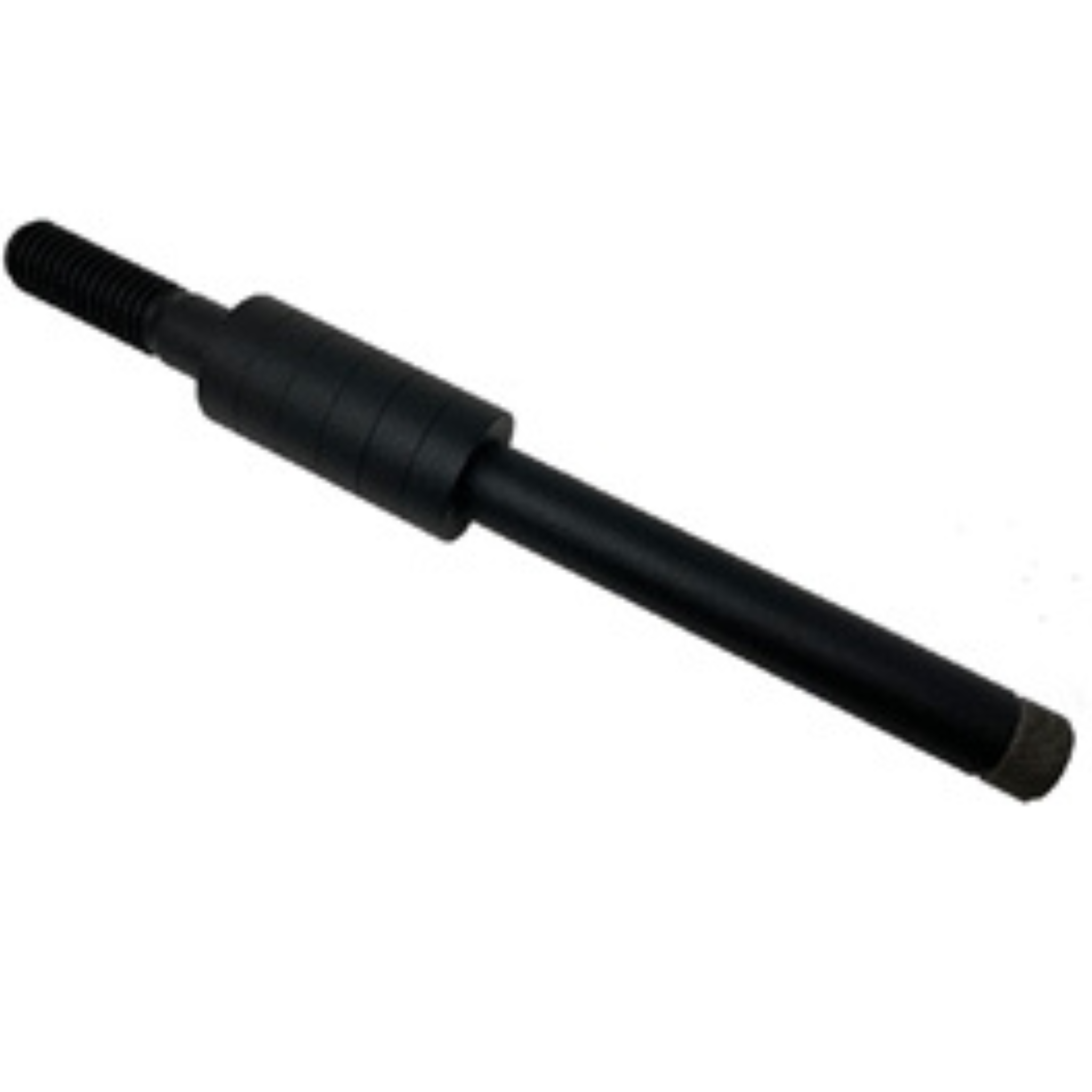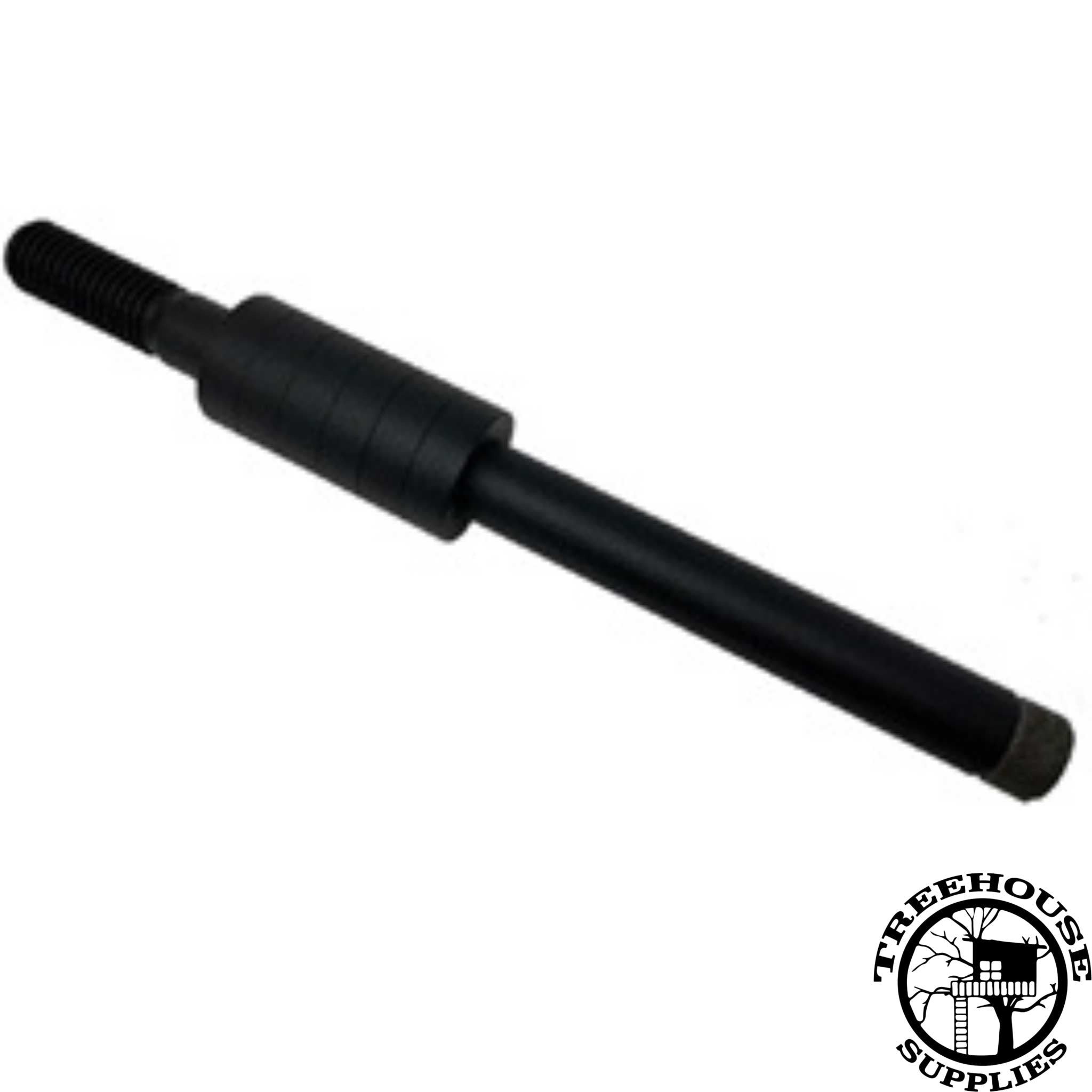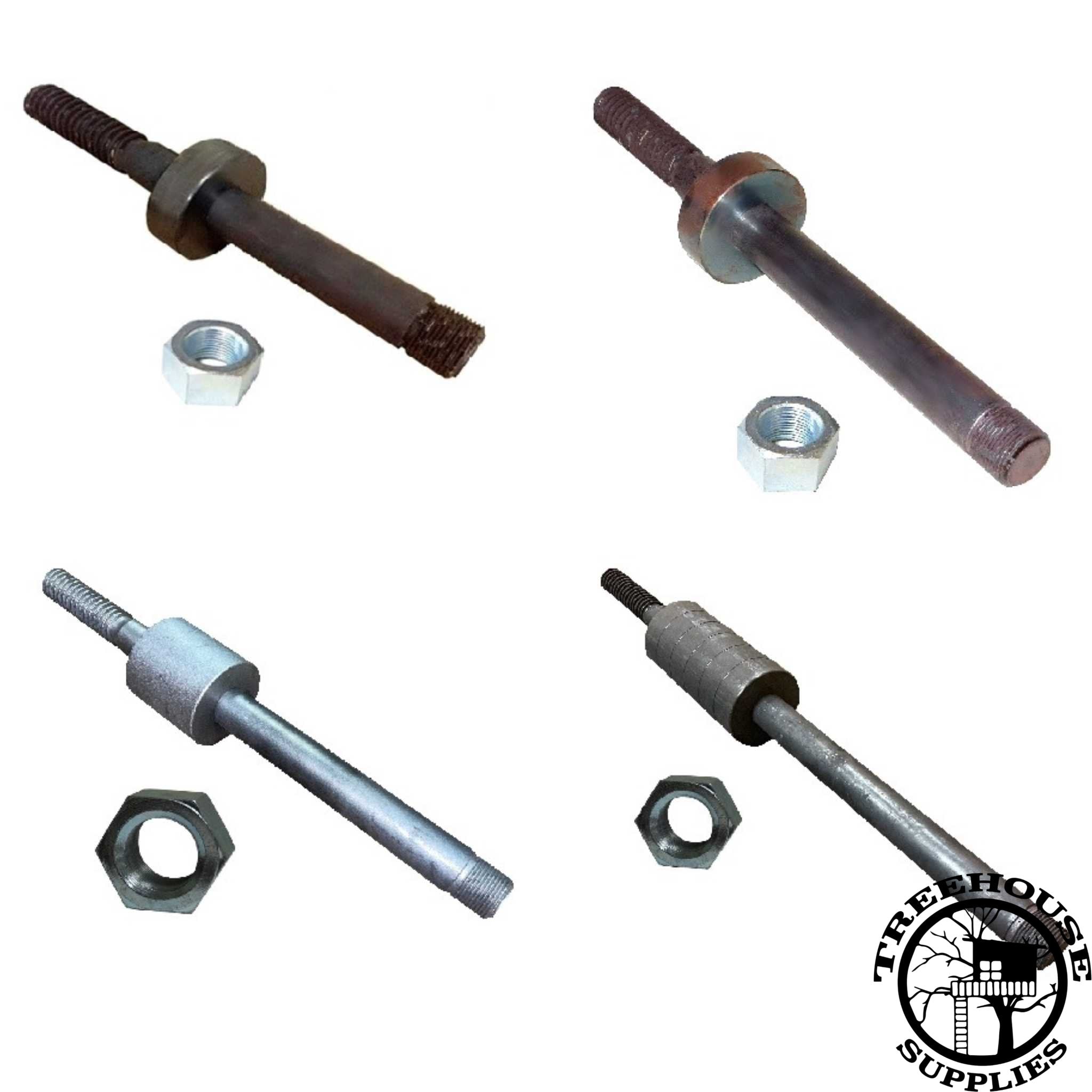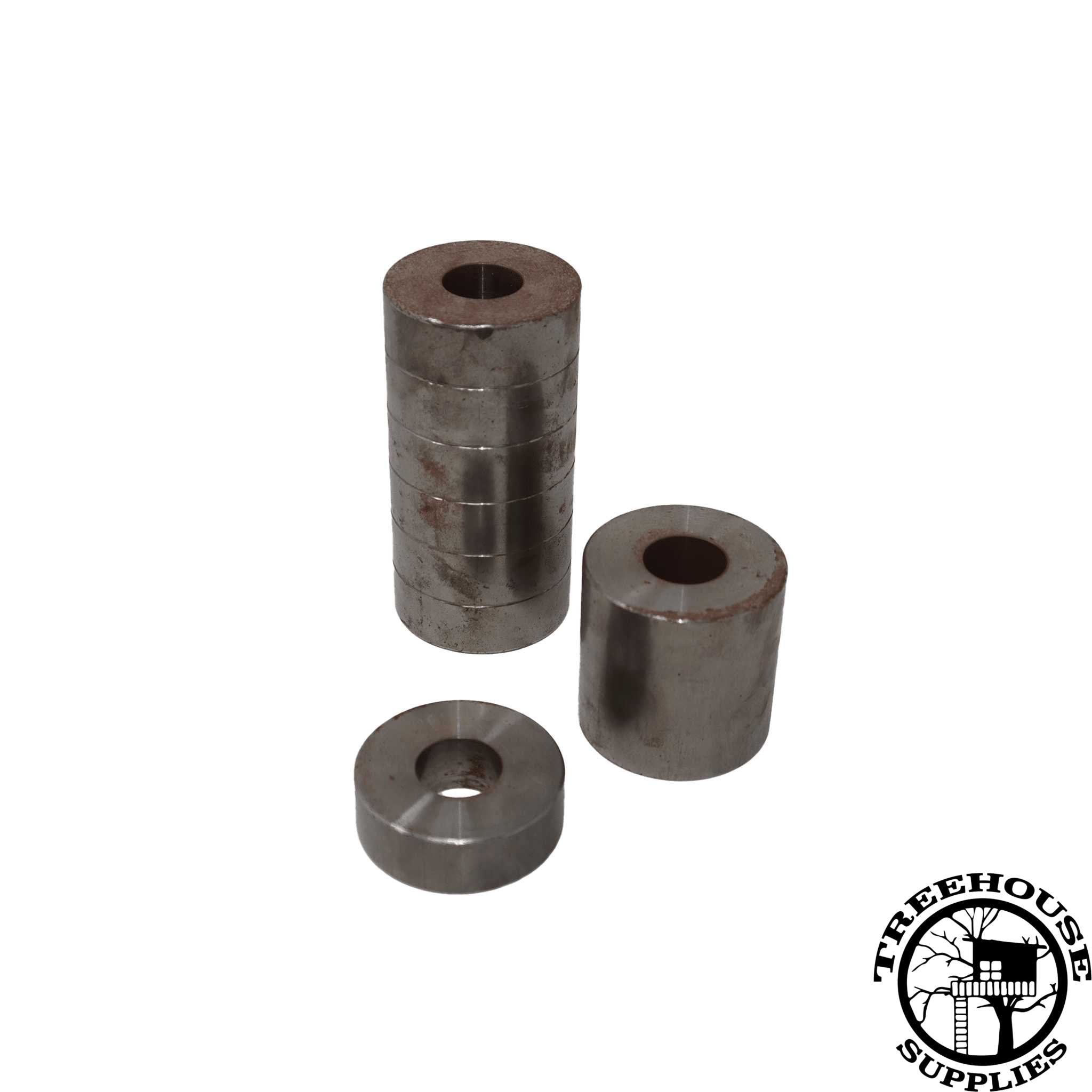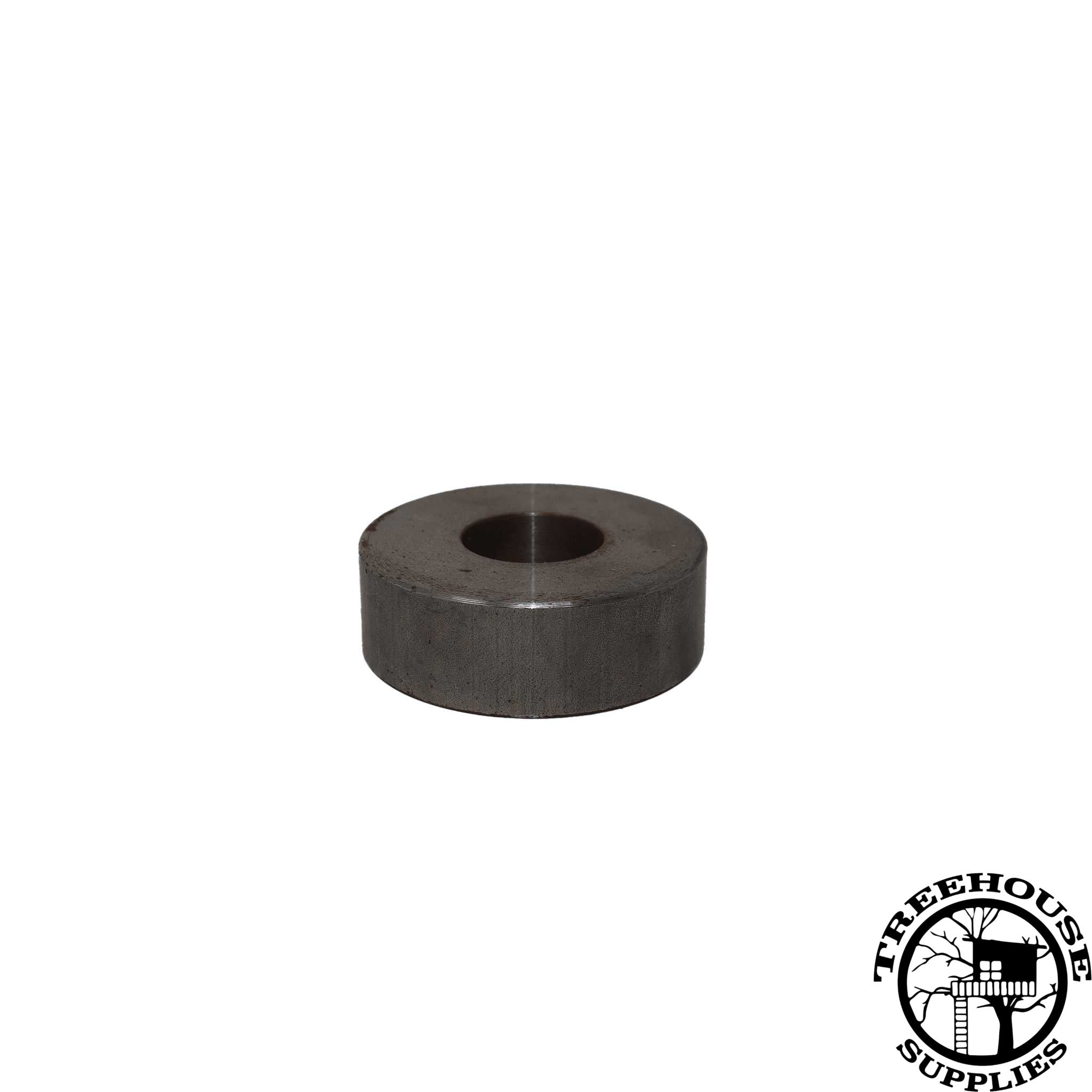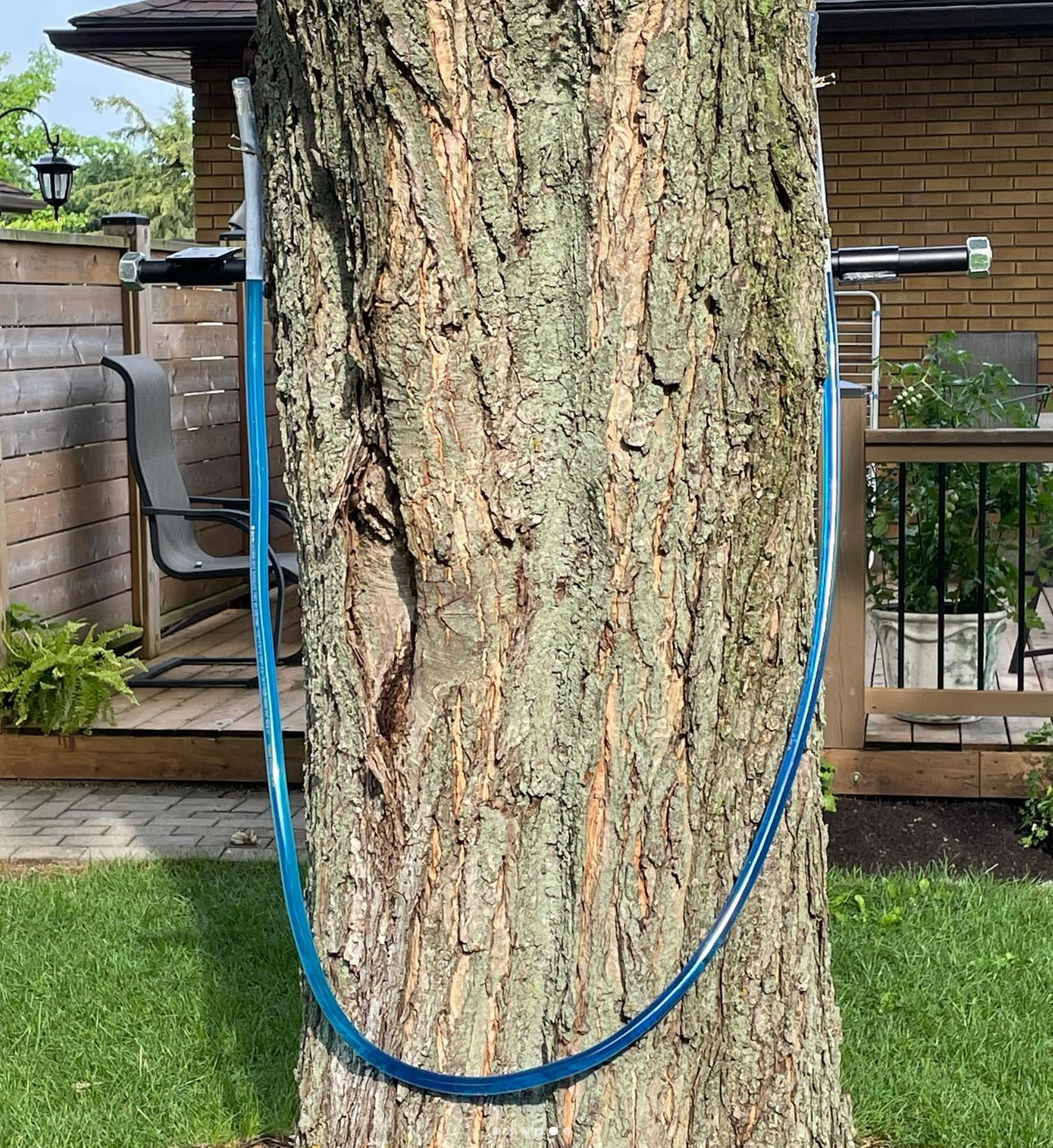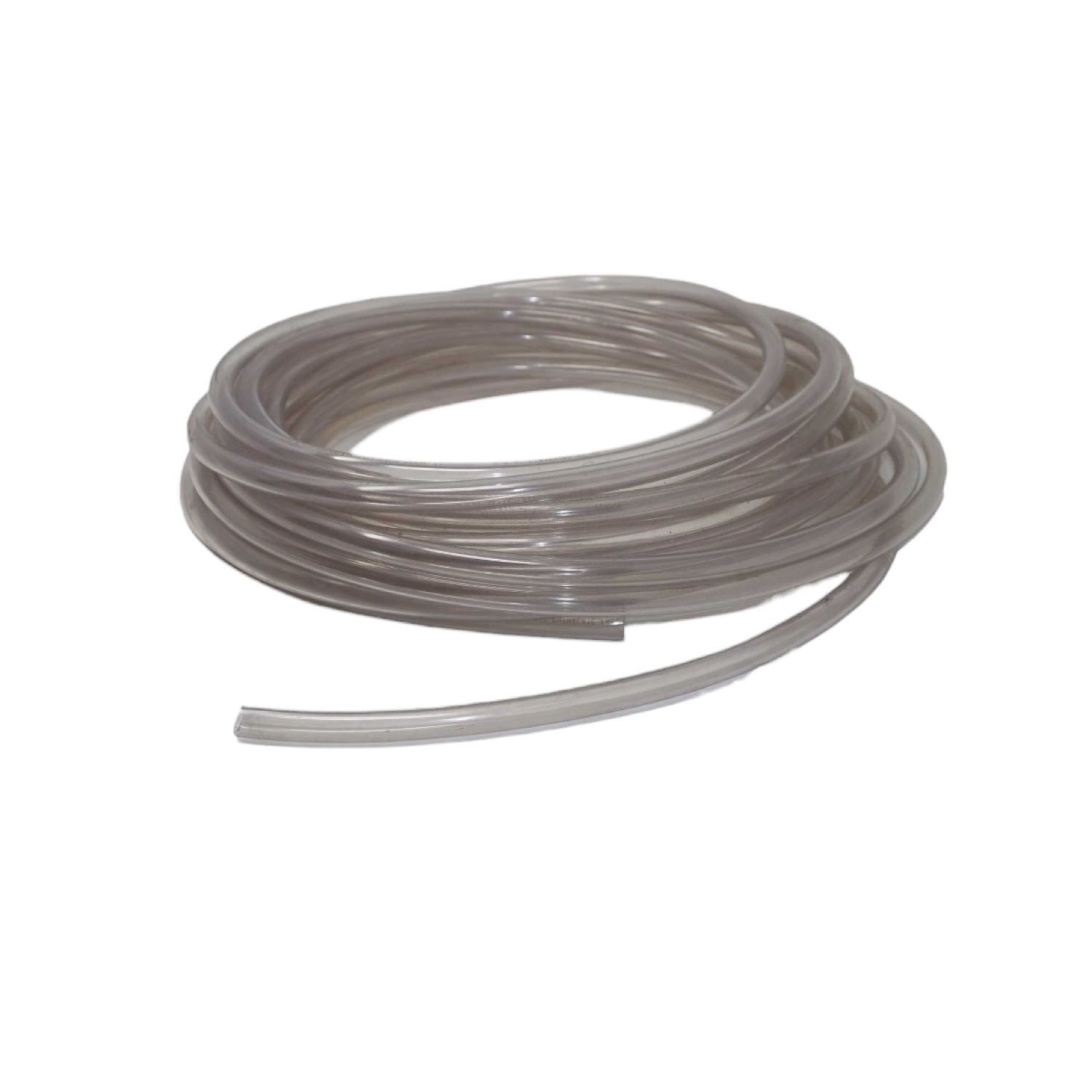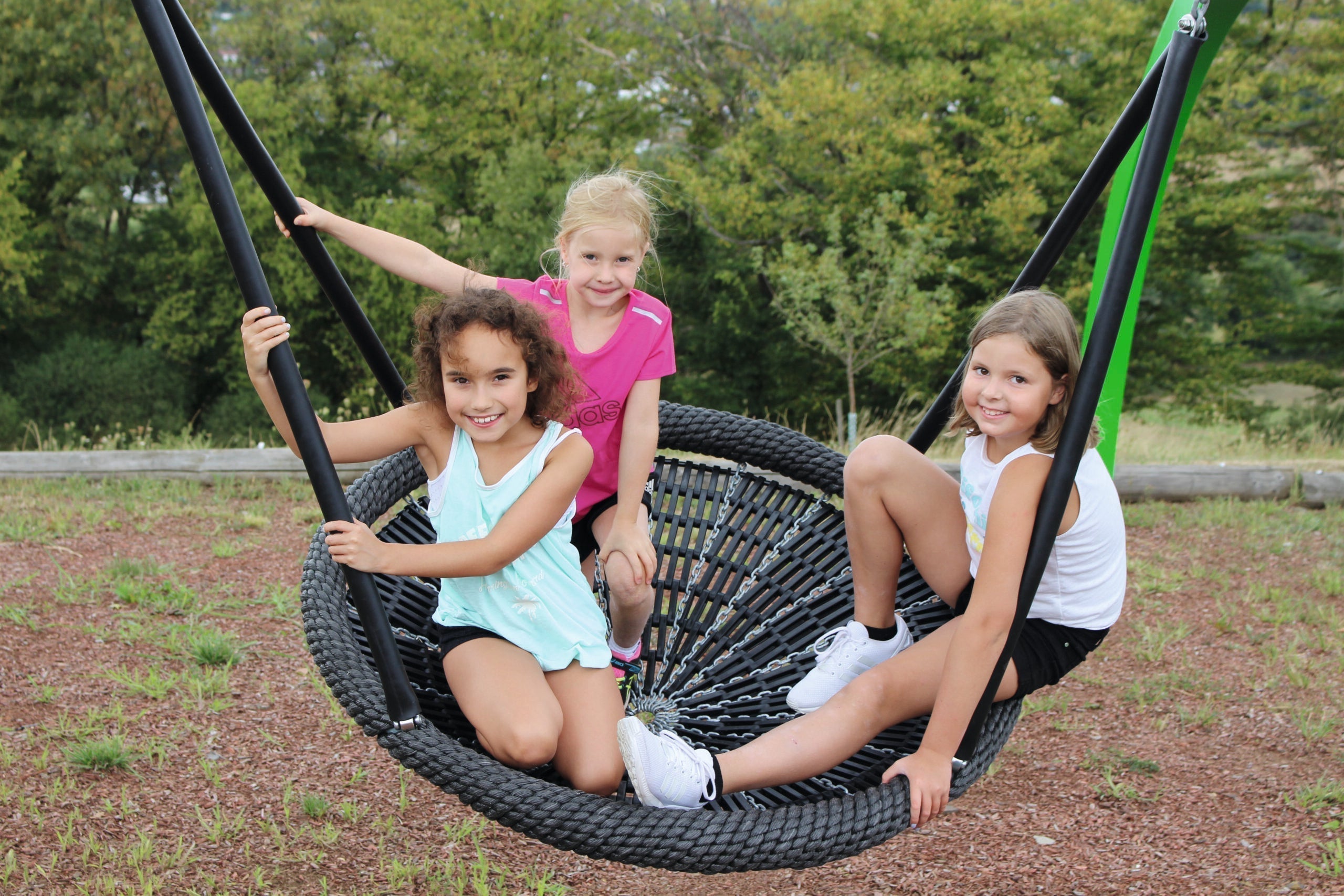Treehouse Attachment Bolts (TAB) - Powder Coated
Treehouse Attachment Bolts (TAB) - Powder Coated
- Free US Shipping on Orders over $350
If you’re looking to elevate your treehouse project with fasteners that are as durable as they are beautiful, powder-coated Treehouse Attachment Bolts are a no-brainer. They deliver next-level corrosion protection, tree safety, and aesthetic appeal — all from a trusted source in the treehouse building community. All our bolts and brackets are designed to allow the trees movement and growth, keeping your outdoor investment secure and the trees healthy.
For over a quarter century, Treehouse Attachment Bolts (TAB) have been an integral part of the modern treehouse industry. These specialized bolts have been engineered to hold between 1,500 lbs to over 10,000 lbs depending on the bolt specifications, tree type and leverage applied. Through their popularity, TABs have shown to be the most accessible and effective method in accomplishing tree house goals.
However, TABs would be incomplete without a wide variety of compatible brackets, fitted to support treehouse of all sizes, shapes, heights and in a multitude of ways.
Our professionally powder coated TABs offer an additional layer of protection against the elements, providing more longevity and prolonging your project.
Please note:
For Treehouse Attachment Bolt installation, we recommend using our:
- Drill Bit Rental Kit for boring the hole the TAB will sit in.
- TAB Ratchet for turning in the TAB w/o damaging the exterior.
- Water Level Tube if 2 or more TABs are to be installed.Only 1¼" brackets will work with TABs.
Benefits of Powder-Coated TABs
-
Corrosion Resistance
Powder coating creates a protective barrier against moisture, rust, and UV exposure, making these TABs ideal for outdoor environments with high humidity, rain, or snow — or simply for builds where long-term appearance and durability are key.
-
Sleek, Low-Profile Look
The deep matte or satin finish of powder-coated TABs blends seamlessly with natural wood and tree bark, creating a subtle, professional look that disappears into the structure instead of standing out.
-
Longer Lifespan
While all TABs are built to last, powder-coated versions offer extra resistance to wear and environmental degradation, especially in coastal or forested environments where exposure to the elements is constant.
-
Minimal Maintenance
Unlike raw or galvanized steel that may require periodic treatment or cleaning, powder-coated hardware retains its finish for years, making your structure more hands-off in the long run.
- These specialized bolts have been engineered to hold between 1,500 lbs to over 10,000 lbs depending on the bolt specifications, tree type, and leverage applied.
- Made of heat-treated steel
- Comes with nut on outside end (fits in 1⅞" socket).
- Color may vary
TAB 1x9 SPECS
- Collar: 1" long, 3" diameter
- Perch: 9" long, 1.25" diameter
- Total Length: 16"
- Threads: 4 threads per inch
- Finish: Heat treated Powder Coat
- Nut: Comes with nut on outside end (fits in 1.875" socket)
TAB 3x9 SPECS
- Collar: 3" long, 3" diameter
- Perch: 9" long, 1.25" diameter
- Total Length: 18"
- Threads: 4 threads per inch
- Finish: Heat treated Powder Coat
- Nut: Comes with nut on outside end (fits in 1.875" socket)
TAB 6x12 SPECS
- Collar: 6" long, 3" diameter
- Perch: 12" long, 1.25" diameter
- Total Length: 24"
- Threads: 4 threads per inch
- Finish: Heat treated Powder Coat
- Nut: Comes with nut on outside end
CHECK OUT THESE ARTICLES AND VIDEOS ON TREEHOUSE SUPPLIES TABS:
How we test the strength of our TABS
How to install TABS
TAB Installation Guide (download)
- What are TABs? Which parts does it include? How’s the installation process?
TABs are an adaptation of timber bolts with built-in sheer collars. Since the late 1990s, the ideas have been applied to treehouse construction.
Our TABs, in their current form, are the best-performing treehouse bolts in the industry based on side-by-side testing.
Our TABs are the strongest TAB on the market.
For an introduction to the parts of the TABs, see our TABs 101 video here: https://www.youtube.com/watch?v=iRDiUgL8S3s&themeRefresh=1
- Which TAB size do I need?
The best TAB size is a factor of the design loading on the tree attachment point, the species of tree you are building in, and the safety factor for your design.
- Design loading is something that engineers figure out to determine how strong to design a structure – it is based on building codes, whether commercial or residential and geography (zones for high wind or snow).
- Tree species can vary in North America by approximately a 5:1 ratio, with the hardest trees, like live oak or some of the hickories outperforming ponderosa pine or eastern white pine by 4x to 5x. In most cases, our TABs do not fail, but the wood of the tree can crush beneath the TAB, causing it to tilt down when overloaded. A larger TAB will support more before the wood crushes.
- Safety Factor: If you think the max load at a given point will be 3000 pounds, then you may decide to get a TAB that will support 6000 or 9000, and that would give you a 2:1 or 3:1 safety factor, respectively.
If you prefer to have “extra support” so that you cover your anticipated loads with a safety factor, then upgrade the hardware to play it safe.
- We have various options for consultations to review your intended plans, evaluate your tree species, and make hardware recommendations. You’ll get advice on hardware and learn more about construction. We have decades of experience with over 1000 treehouses.
- If cost is no object, larger TABs are better. Our affiliated construction company, Tree Top Builders (www.treetopbuilders.net), seldom uses 1” collars for construction, except in rare situations. The 3x9 and 6x12 TABs are their standard.
- How much do TABs hold?
The smallest TABs with 1” collars, such as our 1x6 or 1x9 TABs, have been tested at 2,000 – 12,000 pounds each, based on the type of tree.
Some of our systems built with larger TABs hold over 30,000 lbs. However, there are some disclaimers:
- Do not make the mistake of assuming that all TABs in a treehouse are supporting an equal amount of load.
- Do not forget to account for dead load, live load, and other loads such as snow, wind, etc.
- Do not assume that a TAB from another company will support our exact amounts. Our TABs in side-by-side testing supported 60% more than some of our competition, producing look-alike products by taking shortcuts in the manufacturing process to save a few bucks.
- My treehouse has grown, and it needs new tabs. What can I do?
If possible, we prefer to work with the existing hardware because it’s better for the tree and usually saves you money and time too!
We make extension brackets that can get you more years of use from the same TAB.
These solutions are custom. So if you have any doubts, please feel free to contact us here!
https://www.treehousesupplies.com/pages/contact
- What is the smallest size tree I can attach tabs to?
The smallest size tree you can attach tabs to would depend on the tab used and the tree itself.
However, typically, the smallest tree we have seen being used is a 10" tree.
- Why do we need two static and two dynamic arrestors when using TABs? Why not only dynamic arrestors?
We understand you might be wondering about using static and dynamic arrestors when using TABs.
While we don't currently have plans for two static and two floating arrestors, we can provide some general information.
In most cases, when there are multiple trees, one is static, and the rest are floating. If there are any posts, all tree connections are floating (dynamic).
- Can TABs be removed once installed?
TABs and other treehouse bolts can be removed, but there is a potential risk of causing additional damage to the tree during the process.
The level of risk is relatively low if the bolts were recently installed. However, if the tree has grown around the TAB collars, removing the bolts may require some tree tissue removal, increasing the risk.
Considering the potential for damage upon removal and the extra damage caused by reinstalling the bolts in a different location on the tree, we generally explore alternative options before attempting to reuse the bolts.
These alternatives could involve modifying the brackets, using different lumber sizes, adding spacers, or making other small design changes depending on the specific situation. If possible, it's always best to use the bolt in its original location.
When it comes to removing the bolt, you may be able to turn it out backwards using the same wrench you used to install it. However, with TABs, it is usually not possible to back them out using the nut on the end, so you will likely need a large pipe wrench and turn it out by the perch/shaft. To protect the powder coating and minimize stress on the metal, we recommend wrapping the tab in thick rubber inside the jaws of the pipe wrench. You may also need to use a pipe on the back of the pipe wrench handle to gain enough leverage for removing a TAB.
If removed properly, our TABs can be reused to support a treehouse. However, be cautious not to install the bolt too close to the original hole, as this may cause the two wounds in the tree to join together. While the recommended distance may vary, a conservative rule of thumb is to have 24 inches of vertical separation and 6 inches of horizontal separation.
Compatible with
Our Tree Attachment Bolts (TABs) are not assigned specific weight ratings. Their load-bearing capacity is contingent on factors like tree species, tree health, and a range of other elements. We strongly advise connecting with one of our team members if you are unsure what bolts to purchase.
Free Shipping On All Treehouse Supplies orders over $350*
Order total excluding shipping must be over $349.99. *Free Shipping applies only to the contiguous United States of America and is sent Economy. Processing times can vary but we strive to ship all pending orders within 3-5 business days. Processing times are contingent on size, complexity, and availability of items on the order. Custom items, including hammock nets, will have individual lead times based on fabrication time. After we ship your order, you can expect to have it arrive within 1-3 business days (4-8 days for the west coast or international) depending on the distance from our warehouse to your shipping address. If you need the item sooner than a week, please upgrade the shipping method or call us to discuss options and estimates. Oversized items are excluded from free shipping. These items generally must be picked up or sent by freight carrier. Please contact us for details, verification, or shipping estimates.
Pickups in West Chester, PA, are also available by appointment (for most items in our store).
PLEASE NOTE: International orders may be subject to Duties and Taxes by the receiving country. These fees are not charged at checkout, they will be billed to you on delivery. These Duties and Taxes are the sole responsibility of the recipient. Since the amount varies depending on the country, TreeHouse Supplies, Inc. is not able to estimate the amount prior to shipping the order. If you have questions about Duties and Taxes, you should contact the appropriate government office in your receiving country and determine the amount you will be required to pay. If you refuse to pay the duties and taxes, the shipping company will deny delivery of your order and return it to TreeHouse Supplies, Inc. If this happens, we will deduct the cost of the return shipment from your refund amount. If we receive a bill for duties and taxes unpaid by you the customer, we will invoice you for those fees.
We will not ship with freight forwarding companies.
Express Order Restrictions:
Express orders must be received by 2pm EST to be guaranteed to ship that day. Express orders received after that time will be sent out the following day. Some exceptions may be made but they are at the sole discretion of Tree House Supplies, Inc. If you have an emergency and need parts delivered by express service, but have missed the cut-off time, contact us and we will try to accommodate you. We may charge a fee if the shipment has to be hand delivered to the commercial shipper. The fee is based on a case-by-case basis. Some products that require customization or special orders are not available for immediate shipping - i.e. Bridge Kits, Rustic Swings. If you are unsure, contact us for clarification.
TENTSILE SHIPPING POLICY
We are currently offering Free Shipping for all orders of Tentsile products over $99. Average shipping times are 3-5 days, and there are no taxes or duties added to the quoted purchasing price for these territories.
We offer Route as a tracking and insurance service for the safe delivery of your high ticket items. Route will be added at checkout and they will replace your unit if it is damage, lost or stolen. You are able to take Route off your order, but this will be at your own risk.
Our offer of Free Shipping applies only to the first attempt of delivery. It is your responsibility to use the tracking number provided, to ensure that delivery can take place on the first attempt. You may be charged at local rates for a second attempt.
Please note that if you change your mind after the product has shipped, the return shipping cost will be deducted from your refundable amount. We do not accept PO Box addresses.
If you still have questions, please get touch with our Customer Service team and they will be happy to help provide you with a shipping quote. contact us
ROUTE PACKAGE PROTECTION
We’ve partnered with Route—a package protection and tracking solution—to give our customers the best possible delivery experience. Route provides low-cost shipping protection to protect your package in the event that it gets lost, stolen, or damaged while in transit.
Route is also a mobile app that allows you to visually track all of your online orders in one place. No need to dig through your email for tracking numbers. Route’s dynamic maps and real-time shipping updates keep you in the loop throughout every part of your delivery. The Route app is available on Android and Apple app stores.
If you experienced an issue with your order, please file a claim with Route’s team here.
What is Route Package Protection?
Route's Package Protection is a package protection solution that helps cover your order in the event that your order gets lost, stolen, or damaged while in transit. We know how frustrating it is to have something happen to your order, so we’ve partnered with Route to offer added assurance that you’re supported, no matter what. Package Protection can be added during checkout.
You can also utilize the Route App to visually track all of your online orders in one place and easily file a claim with their team. Whether you’re tracking via the Route App or online Route’s real-time shipping updates keep you in the loop throughout every part of your delivery. Haven’t downloaded the app yet? Download here
Purchased Route's Package Protection and looking to file a shipping issue online? File here
Where is My Order?
Once your order has been fulfilled by our team, a shipping confirmation with a tracking number will be emailed. You can download Route’s mobile app for iOS or Android to visually track your package and receive real-time notifications on its estimated delivery.
How Does Route Work?
If your Route-protected order ends up lost, damaged, or stolen, Route’s expert support team helps ensure that your order gets replaced or refunded as preferred. Claims will be reviewed for approval within 1-2 business days from filing.
Need to file a claim? File here
How Does Route Process Refunds or Reorders?
Refunds: When refunding an item, Route covers the subtotal, shipping, and taxes if the merchant has Automatic Issue Resolution enabled.
In both cases, the Route Premium cost will not be refunded.
Reorders: Route will reorder the items, depending on in-stock availability. Unavailable items will be refunded. Route will cover the cost of any reorders including shipping, taxes, and Route Shipping Protection.
When Should I File a Claim?
Marked As Delivered (Stolen)
- Claims will be reviewed no earlier than 5 calendar days and no later than 30 calendar days from when it was marked delivered.
Stuck In Transit (Lost)
- For domestic orders, claims will be reviewed no earlier than 2 calendar days and no later than 30 calendar days from the last update. The maximum filing time is 365 days from the order date.
- For international orders, claims will be reviewed no earlier than 20 calendar days and no later than 30 calendar days from the last update. The maximum filing time is 365 days from the order date.
Damaged
- Claims for damaged items require photos of the packaging and item(s) and must be filed no later than 30 calendar days from when it was marked delivered.
All of Route’s policies are listed here
What if My Order Never Arrives or is Stolen?
Route definitely helps cover these instances! To protect your order against loss or theft, add Package Protection at checkout.
If your order has not arrived, please file a claim with Route here.
What if My Order Arrives Damaged?
Route covers damage as well! To protect your order against damage that occurred during shipping, add Route Protect at checkout.
If your order has arrived to you damaged, please take photos of the item and the packaging it arrived in to include in your claim when filing.
You can file a claim with Route here.
If your order has defects or you suspect it was damaged during manufacturing, please reach out to us and we will be happy to work with you to remedy the situation.
How Do I File a Claim for my Lost, Damaged, or Stolen Order?
If you insured your order with Route at checkout, you will receive a confirmation email from Route with a link to file a shipping issue.
You can also file a shipping issue on Route’s app or via the web here. To file a claim, you will need your store order number OR Route ID number and the email address that was attached to the order.
Haven’t downloaded the app yet? Download here
What are Route’s Terms and Conditions?
Route’s terms and conditions are listed here: https://route.com/terms-and-conditions/
Is Route a Licensed Insurance Company?
While Route itself is not an insurance company, Route is authorized to provide access to shipping insurance. It does this through its entity, Route Insurance Solutions, which is a licensed insurance producer. This makes Route's Protect product legal and compliant for brands to offer as shipping insurance to their customers.
FAQs for Full Coverage Customers
What is Route Package Protection?
Route's Package Protection is a package protection solution that helps cover your order in the event that your order gets lost, stolen, or damaged while in transit. We know how frustrating it is to have something happen to your order, so we’ve partnered with Route to offer added assurance that you’re supported, no matter what. We're providing Package Protection to each order free of charge.
You can also utilize the Route App to visually track all of your online orders in one place and easily file a claim with their team. Whether you’re tracking via the Route App or online Route’s real-time shipping updates keep you in the loop throughout every part of your delivery. Haven’t downloaded the app yet? Download here
Purchased Route's Package Protection and looking to file a shipping issue online? File here
Where is My Order?
Once your order has been fulfilled by our team, a shipping confirmation with a tracking number will be emailed. You can download Route’s mobile app for iOS or Android to visually track your package and receive real-time notifications on its estimated delivery.
How Does Route Work?
If your order ends up lost, damaged, or stolen, Route’s expert support team helps ensure that your order gets replaced or refunded as preferred. Claims will be reviewed for approval within 1-2 business days from filing.
Need to file a claim? File here
How Does Route Process Refunds or Reorders?
Refunds: When refunding an item, Route covers the subtotal of the order. Shipping costs, taxes, and the Route premium are not included for merchants who do not have Automatic Issue Resolution (AIR), also known as Resolution via Platform (RVP).
Reorders: Route will reorder the items, depending on in-stock availability. Unavailable items will be refunded. Route will cover the cost of any reorders including shipping and taxes.
When Should I File a Claim?
Marked As Delivered (Stolen)
- Claims will be reviewed no earlier than 5 calendar days and no later than 30 calendar days from when it was marked delivered.
Stuck In Transit (Lost)
- For domestic orders, claims will be reviewed no earlier than 2 calendar days and no later than 30 calendar days from the last update. The maximum filing time is 365 days from the order date.
- For international orders, claims will be reviewed no earlier than 20 calendar days and no later than 30 calendar days from the last update. The maximum filing time is 365 days from the order date.
Damaged
- Claims for damaged items require photos of the packaging and item(s) and must be filed no later than 30 calendar days from when it was marked delivered.
All of Route’s policies are listed here
What if My Order Never Arrives or is Stolen?
If your order has not arrived, please file a claim with Route here.
What if My Order Arrives Damaged?
If your order has arrived to you damaged, please take photos of the item and the packaging it arrived in to include in your claim when filing.
You can file a claim with Route here.
How Do I File a Claim for my Lost, Damaged, or Stolen Order?
You can file a shipping issue on Route’s app or via the web here. To file a claim, you will need your store order number OR Route ID number and the email address that was attached to the order.
Haven’t downloaded the app yet? Download here
What are Route’s Terms and Conditions?
Route’s terms and conditions are listed here: https://route.com/terms-and-conditions/
Is Route a Licensed Insurance Company?
While Route itself is not an insurance company, Route is authorized to provide access to shipping insurance. It does this through its entity, Route Insurance Solutions, which is a licensed insurance producer. This makes Route's Protect product legal and compliant for brands to offer as shipping insurance to their customers.
